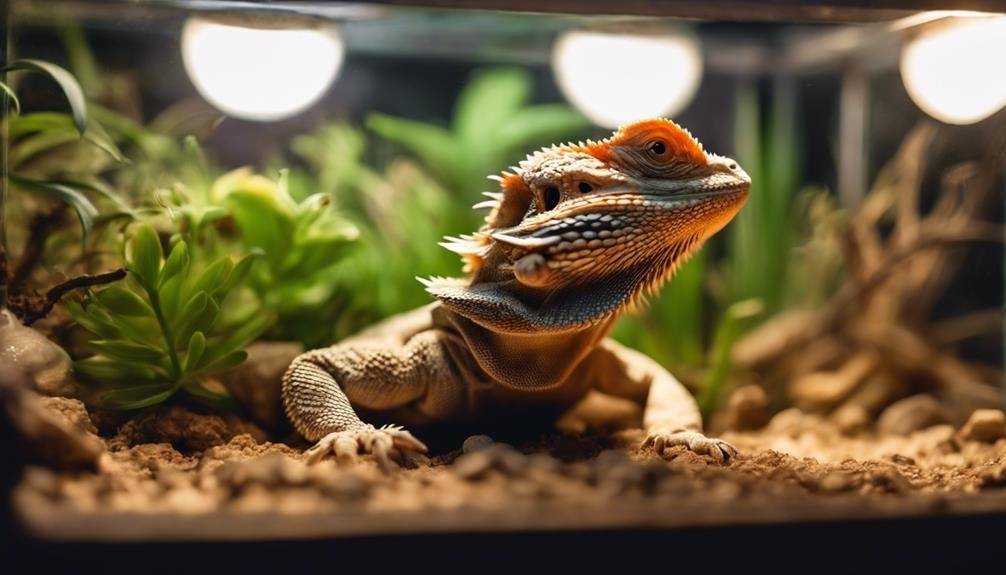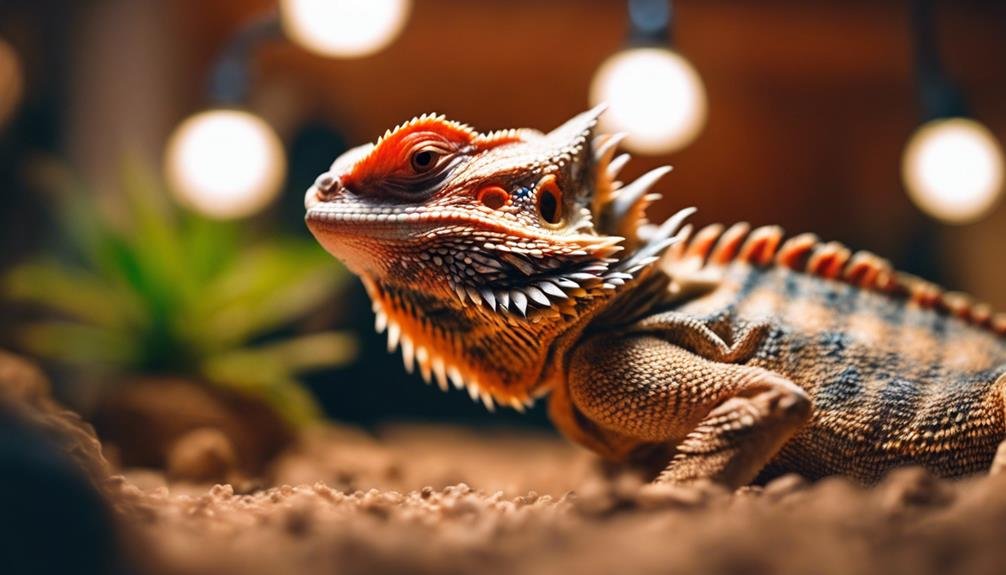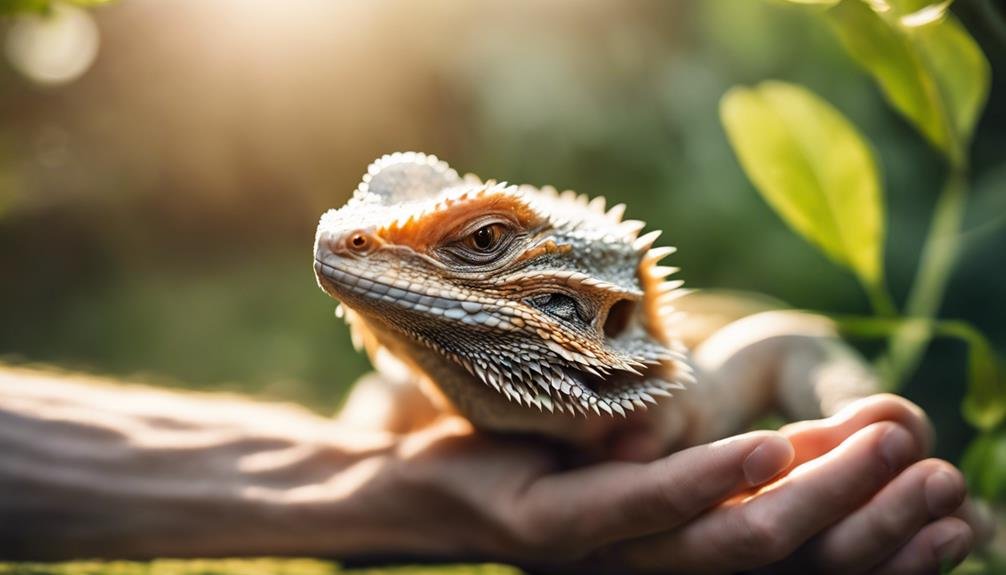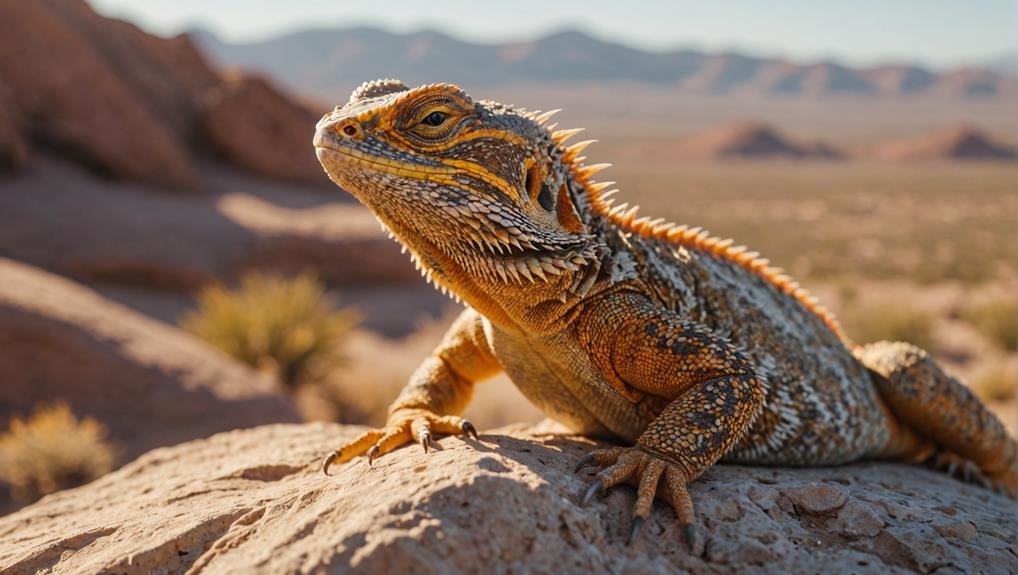When caring for an adult bearded dragon, you’ll notice their distinct physical traits and behaviors that set them apart from their younger counterparts. Understanding their needs, such as ideal habitat requirements and dietary preferences, is essential for their health and happiness. Have you ever wondered how to create the perfect environment mimicking their natural habitat or what foods keep them thriving? By addressing these questions, you can provide the best care for your bearded dragon, ensuring a long and healthy life. There are several key aspects to take into account, and they might surprise you.
Key Takeaways
- Adult bearded dragons grow to 16-24 inches and weigh 380-510 grams.
- Provide a 4-foot-long tank with climbing structures, hiding spots, and basking areas.
- Maintain daytime basking temperatures up to 105°F with essential UVB lighting.
- Feed a balanced diet of insects, leafy greens, and occasional fruits, with calcium and vitamin D3 supplements.
- Signs of illness include lethargy, loss of appetite, abnormal stool, and difficulty breathing.
Physical Characteristics


Adult bearded dragons usually grow to 16 to 24 inches and weigh between 380 to 510 grams. As they mature, you’ll notice their bodies become stockier than their juvenile counterparts. This change isn’t just about size; their colors and patterns become more defined, making each adult bearded dragon unique.
One fascinating aspect of adult bearded dragons is their variety of color morphs. These color morphs can range from vibrant oranges and reds to more subdued shades of brown and gray. You might find it intriguing to see how these color morphs develop and change as your dragon grows.
Another thing you’ll observe is the clear gender differences that become apparent in adulthood. Male bearded dragons typically have larger heads and more pronounced behaviors than females. For instance, males often display head-bobbing and darkened beards as part of their territorial or mating behaviors.
Understanding these physical characteristics will help you better appreciate and care for your adult bearded dragon. Whether admiring their 24 inches in length or marveling at the range of color morphs, knowing what to expect makes the experience much more rewarding.
Ideal Habitat
Establishing the perfect environment for your bearded dragon guarantees their health and happiness as they mature and exhibit their distinctive physical characteristics. Start by choosing a spacious enclosure, ideally a 4-foot-long tank, to accommodate your adult dragon. This space allows them the freedom to move around, climb, and explore, which is crucial for their well-being.
Consider adding climbing structures, hiding spots, and basking areas when setting up the enclosure. These features mimic their natural habitat and promote their instinctual behaviors. Opt for safe and easy-to-clean options like Sani Chips or aspen chips for substrate. This helps maintain a clean environment and reduces the risk of impaction, a common issue in bearded dragons.
Here’s a quick reference table to help you set up the ideal habitat:
| Element | Description |
|---|---|
| Enclosure Size | 4-foot long tank for adult bearded dragons |
| Climbing Structures | Branches, rocks, and platforms |
| Hiding Spots | Caves, hides, and foliage |
| Substrate | Sani Chips or aspen chips |
Creating this environment will ensure your adult bearded dragon thrives, showing off their unique and fascinating behaviors while staying healthy and happy.
Heating and Lighting


To keep your bearded dragon healthy, you must provide adequate heating and lighting in their enclosure. Bearded dragons thrive in environments where the daytime basking temperature reaches up to 105 degrees Fahrenheit. This high heat is crucial for proper digestion and metabolism.
Equally significant is UVB lighting. Bearded dragons require UVB light to synthesize vitamin D3, which in turn helps them absorb calcium. Without sufficient UVB lighting, your dragon could suffer from metabolic bone disease, leading to serious health issues.
Here’s a quick checklist for setting up your bearded dragon’s heating and lighting:
- Daytime Heating: Ensure your enclosure has a basking spot reaching 105 degrees Fahrenheit.
- UVB Lighting: Use a UVB bulb specifically designed for reptiles. Position it so your dragon can bask within 12-18 inches of the light source.
- Nighttime Temperatures: Avoid the temperature from dropping below 72 degrees Fahrenheit to maintain metabolic functions during rest.
Newer mercury vapor bulbs can be convenient, providing heat and UVB light.
Diet and Nutrition
Ensuring your bearded dragon receives a balanced diet of insects, leafy greens, and occasional fruits is essential for their best possible nutrition. Adult dragons thrive on a mix of proteins and vegetables. Leafy greens should make up a significant portion of their diet, with options like collard greens, mustard greens, and dandelion greens being excellent choices.
Here’s a quick reference table for an ideal diet:
| Food Type | Examples |
|---|---|
| Leafy Greens | Collard greens, Mustard greens, Dandelion greens |
| Feeder Insects | Crickets, Roaches, Mealworms |
| Fruits | Blueberries, Strawberries, Mango |
| Supplements | Calcium, Vitamin D3 |
Feeding adult dragons a variety of feeder insects provides protein and encourages natural hunting behaviors, fulfilling their exercise needs. Dusting their food with calcium and vitamin D3 supplements is a crucial husbandry technique to prevent metabolic bone disease.
While adult bearded dragons may eat less frequently than juveniles, maintaining a consistent feeding schedule is important. Monitor their diet regularly to ensure they get a balanced nutrient mix. This practice supports their overall health and longevity, ensuring they remain active and vibrant.
Common Behaviors


Adult bearded dragons often display a range of fascinating behaviors that reflect their instincts and individual personalities. You’ll notice that they’re typically more docile and less skittish compared to their younger counterparts. This calm demeanor makes them more tolerant of handling and interaction, which is a delight for any owner.
Here are three common behaviors you might observe in adult bearded dragons:
- Head Bobbing and Arm Waving are common signs of territorial displays or mating rituals. Head bobbing can indicate dominance, while arm waving is often a submissive gesture.
- Color Changes: During mating seasons or when feeling threatened, adult bearded dragons can change color, often darkening their beard area to show aggression or stress.
- Basking and Routine Preferences: Adult beardies love basking and often have specific routines. They’ll choose their favorite spots under the heat lamp and may even have preferred hiding places.
Understanding these common behaviors can help you better bond with your reptile friend. Recognizing and respecting their instincts can create a comfortable and enriching environment for your docile adult bearded dragon.
Health and Wellness
To maintain your adult bearded dragon’s health, focus on providing a balanced diet of insects and leafy greens.
Watch for common health issues like metabolic bone disease and respiratory infections.
Guarantee their habitat includes proper UVB lighting and humidity levels to support overall wellness.
Diet and Nutrition
An ideal diet of insects, leafy greens, and vegetables is vital for your adult bearded dragon’s health and wellness. Unlike the juvenile bearded dragon’s diet, which consists mostly of protein to support rapid growth, an adult bearded dragon needs a balanced mix to maintain health.
They require various insects, such as crickets, mealworms, and dubia roaches, which should be gut-loaded to enhance their nutritional value.
In addition to insects, dark leafy greens are important. These greens, such as collard greens, mustard greens, and dandelion greens, provide the calcium and fiber necessary for your dragon. Regularly dusting their food with vitamin and calcium supplements is crucial to help them synthesize vitamin D and prevent deficiencies.
Here’s a quick guide to your bearded dragon’s diet:
- Insects: Gut-loaded crickets, mealworms, and dubia roaches.
- Leafy Greens: Collard greens, mustard greens, and dandelion greens.
- Supplements: Regularly dusting reptile vitamin and calcium supplements.
Fruits can be given as occasional treats, but they shouldn’t make up a significant portion of the diet to avoid health issues. Following these guidelines ensures your bearded dragon remains healthy and happy.
Common Health Issues
Bearded dragons often face common health issues like metabolic bone disease, respiratory infections, parasitic infestations, and impaction. It’s important to monitor your dragon closely for signs of illness, such as lethargy, loss of appetite, abnormal stool, difficulty breathing, and visible injuries.
Metabolic bone disease (MBD) frequently stems from calcium deficiency and inadequate UVB lighting. To prevent MBD, ensure your bearded dragon has access to proper lighting and a balanced diet rich in calcium.
Poor enclosure conditions can lead to respiratory infections, particularly if humidity levels are too high or temperatures are too low. Signs include wheezing, mucus around the nostrils, and labored breathing. Maintaining appropriate temperatures and humidity levels can help avoid these infections.
Impaction is another serious issue often caused by ingesting substrate or consuming oversized food items. Symptoms include bloating, lethargy, and lack of bowel movements. To prevent impaction, provide a suitable substrate and properly size your dragon’s food.
Regular veterinary check-ups are essential for early detection and treatment of these conditions. You can improve your bearded dragon’s overall health and well-being by ensuring proper diet, lighting, hygiene, and environmental enrichment.
Handling Tips


When handling your adult bearded dragon, always support their body to prevent stress or injury. Start by approaching your dragon calmly and confidently. This helps establish trust and makes the handling experience more enjoyable for both of you. While handling, watch their body language to detect any signs of discomfort or stress. If you notice them puffing up their beard, turning black, or trying to squirm away, it’s time to return them to their habitat gently.
To guarantee a stress-free handling session, consider these tips:
- Support their entire body: Use both hands to cradle their torso and tail. This gives them a sense of security.
- Limit handling time: Keep sessions short, ideally no longer than 10-15 minutes. This prevents your dragon from becoming overwhelmed.
- Create positive associations: Offer treats or rewards after handling to build a positive connection with the experience.
Enrichment Activities
After guaranteeing your bearded dragon feels secure during handling, it is important to engage them with enrichment activities to keep them mentally and physically stimulated.
For adult bearded dragons, various climbing structures and basking spots in their enclosure are essential. These features mimic their natural habitat and keep them active and entertained.
Interactive toys like basking platforms, tunnels, and puzzle feeders stimulate their minds. These toys challenge your beardie to think and explore, which can be incredibly rewarding for them.
Incorporating different textures, such as rocks, branches, and hides, adds another enrichment layer. Adult bearded dragons enjoy exploring these diverse elements, keeping them engaged and active.
Supervised outdoor time is another excellent way to provide mental and physical stimulation. Allowing your bearded dragon to soak in natural sunlight and explore new environments can be highly beneficial. Just keep a close eye on them to guarantee their safety.
Conclusion
Understanding your adult bearded dragon’s physical characteristics, creating an ideal habitat, and ensuring proper heating and lighting are key to caring for it.
A balanced diet keeps them healthy while recognizing common behaviors helps you bond with them.
Regular health checks and gentle handling are essential.
Don’t forget to provide enrichment activities to keep them stimulated.
With these tips, you’ll enjoy a rewarding relationship with your fascinating reptile companion.
Related Article
https://thereptileguide.com/corn-snake-care/
https://thereptileguide.com/do-bearded-dragons-like-water-swimming-bathing/


